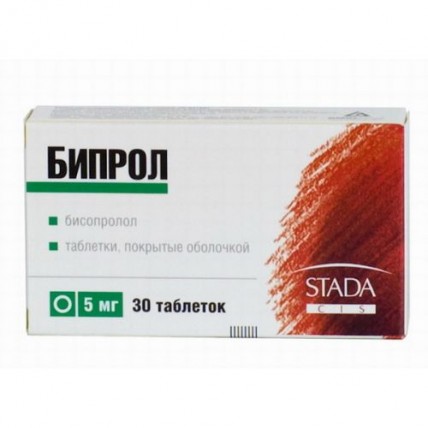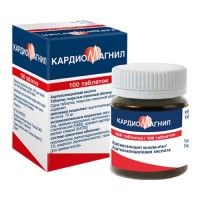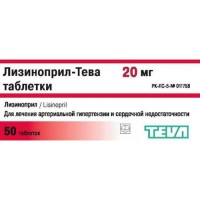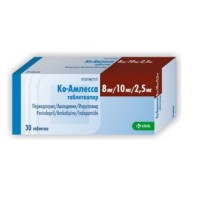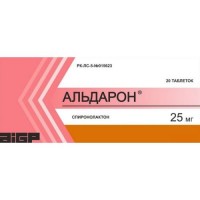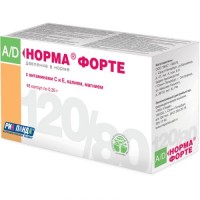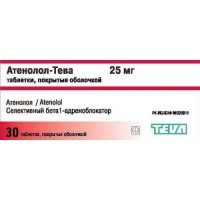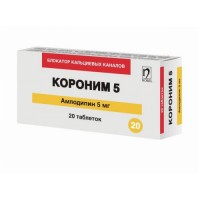Biprol 30s 5 mg film-coated tablets
- $5.70
Trade name
Biprol
Mezhdunarodnoye the unlicensed
name Bisoprolol Lekarstvennaya
the Tablet form, film coated 5 mg, 10 mg
Structure
One tablet contains
active agent – the bisoprolola fumarates 5 mg or 10 mg,
excipients: microcrystalline cellulose, ludipress LCE (lactoses monohydrate – 94.7-98.3%, kollidon 3-4%), starch corn, silicon dioxide colloidal anhydrous (aerosil), krospovidon (Kollidon CL), magnesium stearate,
structure of a cover: titan dioxide (E 171), macrogoal (polyethyleneglycol 4000), gipromelloz (hydroksipropilmetiltsellyuloz), talc, dye tropeolin O.
The description
Round, biconvex tablets, film coated yellow (for a dosage of 5 mg) or dark yellow (for a dosage of 10 mg) colors. On cross section two layers, an inside layer of color, white or white with hardly noticeable creamy shade,
Pharmacotherapeutic group
Beta blockers are visible. Selection beta blockers. Bisoprolol.
The ATX C07AB07 code
the Pharmacological
Pharmacokinetics Absorption properties of a bisoprolol in digestive tract makes 80 – 90%. The maximum concentration in blood plasma is reached in 1-3 h, communication with proteins of blood plasma makes about 30%. Bisoprolol practically does not get through hematoencephalic and placentary barriers.
Bisoprolol is metabolized in a liver, elimination half-life makes 10-12 hours. It is removed by kidneys – 50% in not changed look, less than 2% - with bile.
The pharmacodynamics
Biprola Active agent – bisoprolol – is the high-selection b1-adrenoblocker which does not have internal sympathomimetic activity. Does not possess membrane stabilizing action. Reduces activity of renin of plasma, reduces the need of a myocardium for oxygen, reduces the heart rate (HR) at rest and at loading. Has hypotensive, antiarrhytmic and anti-anginal effect. Blocking in low doses of b1 – heart adrenoceptors, reduces stimulated catecholamines formation of tsAMF from ATP, reduces intracellular current of calcium ions, renders negative hrono-, dromo-, batmo- and inotropic action, oppressing conductivity and excitability, reduces contractility of a myocardium.
At increase in a dose has b2-adrenoceptor blocking effect.
The general peripheric vascular resistance at the beginning of drug use, in the first 24 h, increases (as a result of reciprocal increase of activity of α-adrenoceptors and elimination of stimulation of b2-adrenoceptors), in 1-3 days returns to initial, and at long appointment – decreases.
The hypotensive effect is connected with reduction of minute volume of blood, sympathetic stimulation of peripheral vessels, decrease of the activity system renin-angiotenzinovoy, recovery of sensitivity in response to a lowering of arterial pressure (ABP) and influence on the central nervous system (CNS). In arterial hypertension the effect occurs in 2-5 days, stable action – in 1-2 months.
The anti-anginal effect is caused by reduction of need of a myocardium for oxygen as a result of an urezheniye of ChSS and decrease in contractility, lengthening of a diastole, improvement of perfusion of a myocardium. Due to increase in end diastolic pressure in a left ventricle and increases in stretching of muscle fibers of ventricles bisoprolol can increase oxygen requirement, especially at patients with chronic heart failure.
The antiarrhytmic effect is caused by elimination of aritmogenny factors (tachycardias, superactivity of sympathetic nervous system, the increased maintenance of tsAMF, arterial hypertension), reduction of speed of spontaneous excitement of sinus and ectopic pacemakers and delay of atrioventricular (AV) carrying out (mainly in antegrade and, to a lesser extent, in retrograde the directions through an AV node) and carrying out on additional ways.
At use in average therapeutic doses, unlike non-selective b-adrenoblockers, has less significant impact on the bodies containing b2-adrenoceptors (pancreas, skeletal muscles, smooth muscles of peripheral arteries, bronchial tubes and a uterus) and on carbohydrate metabolism. Does not cause a delay of ions of sodium in an organism. The expressiveness of atherogenous action does not differ from effect of propranolol. At use in high doses (200 mg and more) the blocking effect renders on both subtypes of b-adrenoceptors, mainly, in bronchial tubes and unstriated muscles of vessels.
Indications
- arterial hypertension
- coronary heart disease: prevention of attacks of stenocardia
the Route of administration and doses
the Drug is taken inside, once, in the morning on an empty stomach. The tablet should be swallowed entirely, without chewing.
The daily dose makes 5 mg and can be increased up to 10 mg of 1 times a day.
The maximum daily dose – 20 mg.
At patients with a renal failure, at clearance of creatine less than 20 ml/min., or at patients with the profound abnormal liver functions the maximum daily dose makes 10 mg.
Duration of therapy is determined by the attending physician.
Drug is recommended to be cancelled gradually, reducing a dose within 2 weeks and more (lower a dose by 25% within 3-4 days).
Side effects
- increased fatigue, weakness, dizziness, a headache, sleep disorders, a depression, concern, confusion of consciousness or short-term loss of memory, a hallucination, an asthenia, a myasthenia, paresthesias in extremities (at patients with the alternating lameness and Reynaud's syndrome), a tremor
- disorders of vision, reduction of secretion of plaintive liquid, dryness and morbidity of eyes, conjunctivitis
- sinus bradycardia, heartbeat, disturbance of conductivity of a myocardium, AV blockade (up ment of a total cross block and cardiac arrest), arrhythmias, easing of contractility of a myocardium, development (aggravation) of chronic heart failure (puffiness of anklebones, feet, an asthma), decrease in the ABP, orthostatic hypotension, manifestations of a vasomotor spasm (strengthening of disturbance of peripheric circulation, a cold snap of the lower extremities, Reynaud's syndrome), a stethalgia
- dryness of a mucous membrane of an oral cavity, nausea, vomiting, an abdominal pain, constipations or diarrhea, an abnormal liver function (urine darkening, yellowness of scleras or skin, a cholestasia, hepatitis), change of taste
- feeling of congestion of a nose, difficulty of breath at administration of drug in high doses (loss of selectivity) and/or at predisposed patients – laringo- and a bronchospasm
- a hyperglycemia (at patients with insulinonezavisimy diabetes), a hypoglycemia (at the patients receiving insulin), a hypothyroid state
- a skin itching, rash, a small tortoiseshell
- sweating strengthening, a dermahemia, a dieback, psoriazopodobny skin reactions, aggravation of symptoms of psoriasis, an alopecia
- thrombocytopenia (unusual bleedings and hemorrhages), an agranulocytosis, a leukopenia, change of activity of enzymes of a liver (increase in ALT, nuclear heating plant), the level of bilirubin, triglycerides
- influence on a fruit: a pre-natal growth inhibition, a hypoglycemia, bradycardia
- dorsodynias, arthralgias
- weakening of a libido, decrease in potency
- a syndrome of cancellation (strengthening of attacks of stenocardia, increase in the ABP)
-
the Contraindication hearing disorder
- hypersensitivity to components of drug and other b-adrenoblockers
- shock (including cardiogenic), collapse, a fluid lungs, an acute heart failure, chronic heart failure in a decompensation stage
- AV blockade of the II-III article, sinuatrial blockade, a sick sinus syndrome, the profound bradycardia (ChSS less than 45-50 ud. / mines), Printsmetal's stenocardia
- a cardiomegaly (without symptoms of heart failure)
- arterial hypotension (systolic arterial blood pressure less than 100 mm Hg., especially in a myocardial infarction)
- bronchial asthma and a chronic obstructive pulmonary disease in the anamnesis
- a concomitant use of inhibitors of a monoaminooxidase (MAO) (except for MAO-B)
- late stages of disturbance of peripheric circulation, a Raynaud's disease
- a pheochromocytoma (without simultaneous use of α-adrenoblockers)
- a metabolic acidosis
- children's and teenage age up to 18 years
- pregnancy and the period of a lactation
Medicinal interactions
In pharmakodinamichesky interaction of Biprol with antiarrhytmic drugs I of a class, such as novokainamid, the refractory period of ventricles of heart increases and increases risk of development of pro-arrhythmic effect.
The allergens used for an immunotherapy or extracts of allergens for skin tests increase risk of emergence of heavy system allergic reactions or an anaphylaxis at the patients receiving Biprol.
Iodinated X-ray contrast medicines for intravenous administration increase risk of development of anaphylactic reactions.
Phenytoinum at intravenous administration, medicines for inhalation general anesthesia (derivatives of hydrocarbons) increase expressiveness of cardiodepressive action and probability of decrease in the ABP at the patients receiving Biprol.
Biprol changes efficiency of insulin and oral hypoglycemic medicines, masks symptoms of the developing hypoglycemia (tachycardia, increase in the ABP). Reduces clearance of lidocaine and xanthines (except Diphyllinum) and increases their concentration in blood plasma, especially at patients with initially increased clearance of theophylline under the influence of smoking.
Hypotensive effect of Biprol non-steroidal anti-inflammatory drugs (a delay of sodium and blockade of synthesis of prostaglandin kidneys) weaken, glucocorticosteroids and estrogen (delay of ions of sodium).
The concomitant use of cardiac glycosides, Methyldopums, reserpine and a guanfatsin, blockers of slow calcium channels (verapamil, diltiazem), Amiodaronum and other antiarrhytmic medicines increases risk of development or aggravation of bradycardia, AV of blockade, cardiac arrest and heart failure.
Combined use with nifedipine can lead to considerable decrease in the ABP.
Diuretics, a clonidine, sympatholytics, gidralazin and other hypotensive medicines, at simultaneous use with Biprol, can lead to excessive decrease in the ABP.
Biprol extends action of not depolarizing muscle relaxants and anticoagulating effect of coumarins.
Rub - and tetracyclic antidepressants, antipsychotic medicines (neuroleptics), ethanol, sedative and somnolent medicines strengthen oppression of central nervous system at the patients accepting Biprol.
Simultaneous use of Biprol with MAO inhibitors, owing to considerable strengthening of hypotensive action is not recommended. Having rummaged in treatment between intake of MAO inhibitors and Biprol has to make not less than 14 days.
Not hydrogenated alkaloids of an ergot increase risk of development of disturbances of peripheric circulation at the patients accepting Biprol.
At simultaneous use with Biprol, ergotamine increases risk of development of disturbance of peripheric circulation, Sulfasalazinum increases concentration of a bisoprolol in blood plasma, rifampicin shortens elimination half-life.
Special instructions
Control of the patients accepting Biprol has to include measurement of ChSS and the ABP (in an initiation of treatment - daily, then 1 time in 3-4 months), control of the ECG, blood glucose definition at patients with diabetes (1 time in 4-5 months). At elderly patients it is recommended to monitor function of kidneys (1 time in 4-5 months).
It is necessary to train the patient in a technique of calculation of ChSS and to instruct about need of medical consultation at ChSS less than 50 beats/min.
Before an initiation of treatment it is recommended to conduct a research of function of external respiration at patients with the burdened bronchopulmonary anamnesis.
Approximately at 20% of patients with stenocardia b-adrenoblockers are inefficient. Basic reasons – heavy coronary atherosclerosis with a low threshold of ischemia (ChSS less than 100 ud. / min.) and the increased final diastolic volume of a left ventricle breaking a subendocardial blood stream.
At smokers the efficiency of b-adrenoblockers is lower.
The patients using contact lenses have to consider that against the background of treatment the reduction of products of plaintive liquid is possible.
When using the patients with a pheochromocytoma have a risk of developing paradoxical arterial hypertension (if the effective α-adrenoblokada is previously not reached).
In a thyrotoxicosis Biprol can disguise certain clinical signs of a thyrotoxicosis (for example, tachycardia). Sharp cancellation at patients with a thyrotoxicosis is contraindicated as it is capable to strengthen symptomatology.
In diabetes can mask the tachycardia caused by a hypoglycemia. Unlike non-selective b-adrenoblockers practically does not strengthen the hypoglycemia caused by insulin and does not delay restoration of concentration of glucose in blood to normal level.
At a concomitant use of a clonidine its reception can be stopped only in several days after Biprol's cancellation.
Strengthening of expressiveness of reaction of hypersensitivity and lack of effect of usual doses of epinephrine against the background of the burdened allergological anamnesis is possible.
In case of need performing planned surgical treatment carry out drug withdrawal for 48 h prior to the beginning of the general anesthesia. If the patient took the drug before operation, it should pick up medicine for the general anesthesia with minimum negative inotropic effect.
Reciprocal activation of vagus nerve can be eliminated with intravenous administration of atropine (1-2 mg).
The medicines reducing stocks of catecholamines (including, reserpine), can strengthen effect of b-adrenoblockers therefore the patients accepting such combinations of medicines have to be under constant observation of the doctor regarding identification of the significant lowering of the ABP or bradycardia.
Patients with bronkhospastichesky diseases can appoint cardioselective adrenoblockers in case of intolerance and/or inefficiency of other hypotensive medicines. The overdose is dangerous by development of a bronchospasm.
In case of identification at patients of advanced age of the accruing bradycardia (less than 50 beats/min), the significant lowering of the ABP (systolic arterial blood pressure is lower than 100 mm Hg.), blockade AV, it is necessary to reduce Biprol's dose or to stop treatment.
It is recommended to stop administration of drug at development of a depression.
It is impossible to interrupt sharply treatment because of danger of development of heavy arrhythmias and a myocardial infarction. Cancellation is carried out gradually, reducing a dose within 2 weeks and more (lower a dose by 25% within 3-4 days). Administration of drug should be stopped before a research of content in blood and urine of catecholamines, a normetanefrin and vanilinmindalny acid, credits of antinuclear antibodies.
To apply with care in a liver failure, chronic kidney disease, a myasthenia, a thyrotoxicosis, diabetes, atrioventricular block of the I degree, a depression (including in the anamnesis), psoriasis, at advanced age, at a rigid diet, the continuing desensibilizing therapy, peripheral occlusal damages of arteries (strengthening of symptoms is possible).
The feature of influence of medicine on ability to run the vehicle or potentially dangerous mechanisms
during treatment needs to be careful when driving and performing other potentially dangerous types of activity demanding the increased concentration of attention and speed of psychomotor reactions.
Overdose
Symptoms: arrhythmia, ventricular premature ventricular contraction, profound bradycardia, AV blockade, significant decrease in the ABP, chronic heart failure, Crocq's disease, breath difficulty, bronchospasm, dizziness, unconscious states, spasms.
Treatment: gastric lavage and prescribing of the adsorbing medicines, symptomatic therapy. At the developed AV to blockade - intravenous administration of 1-2 mg of atropine, epinephrine or statement of a temporary pacemaker, in ventricular premature ventricular contraction – lidocaine (the drugs Ia of a class are not used), at decrease in the ABP – the patient has to be in position of Trendelenburg if there are no symptoms of a fluid lungs, intravenously enter plasma substituting solutions, at inefficiency – epinephrine, a dopamine, Dobutaminum (for maintenance of chronotropic and inotropic action and elimination of the significant decrease in the ABP), in heart failure – cardiac glycosides, diuretics, a glucagon, in spasms – enter intravenously diazepam, at a bronchospasm – is inhalation enter b2-adrenostimulyator.
A form of release and packing
On 10 tablets in blister strip packaging from a film of the polyvinylchloride and printing aluminum foil varnished.
On the 3 or 5 blister strip packagings together with the instruction for use in the state and Russian languages put in a pack from cardboard.
To Store storage conditions in the dry, protected from light place at a temperature not over 25 ºС.
To store out of children's reach!
A period of storage
3 years
not to use drug after expiry date.
LLC Hemofarm Producer, Obninsk, the Russian Federation
prescription status According to the prescription
Biprol
Mezhdunarodnoye the unlicensed
name Bisoprolol Lekarstvennaya
the Tablet form, film coated 5 mg, 10 mg
Structure
One tablet contains
active agent – the bisoprolola fumarates 5 mg or 10 mg,
excipients: microcrystalline cellulose, ludipress LCE (lactoses monohydrate – 94.7-98.3%, kollidon 3-4%), starch corn, silicon dioxide colloidal anhydrous (aerosil), krospovidon (Kollidon CL), magnesium stearate,
structure of a cover: titan dioxide (E 171), macrogoal (polyethyleneglycol 4000), gipromelloz (hydroksipropilmetiltsellyuloz), talc, dye tropeolin O.
The description
Round, biconvex tablets, film coated yellow (for a dosage of 5 mg) or dark yellow (for a dosage of 10 mg) colors. On cross section two layers, an inside layer of color, white or white with hardly noticeable creamy shade,
Pharmacotherapeutic group
Beta blockers are visible. Selection beta blockers. Bisoprolol.
The ATX C07AB07 code
the Pharmacological
Pharmacokinetics Absorption properties of a bisoprolol in digestive tract makes 80 – 90%. The maximum concentration in blood plasma is reached in 1-3 h, communication with proteins of blood plasma makes about 30%. Bisoprolol practically does not get through hematoencephalic and placentary barriers.
Bisoprolol is metabolized in a liver, elimination half-life makes 10-12 hours. It is removed by kidneys – 50% in not changed look, less than 2% - with bile.
The pharmacodynamics
Biprola Active agent – bisoprolol – is the high-selection b1-adrenoblocker which does not have internal sympathomimetic activity. Does not possess membrane stabilizing action. Reduces activity of renin of plasma, reduces the need of a myocardium for oxygen, reduces the heart rate (HR) at rest and at loading. Has hypotensive, antiarrhytmic and anti-anginal effect. Blocking in low doses of b1 – heart adrenoceptors, reduces stimulated catecholamines formation of tsAMF from ATP, reduces intracellular current of calcium ions, renders negative hrono-, dromo-, batmo- and inotropic action, oppressing conductivity and excitability, reduces contractility of a myocardium.
At increase in a dose has b2-adrenoceptor blocking effect.
The general peripheric vascular resistance at the beginning of drug use, in the first 24 h, increases (as a result of reciprocal increase of activity of α-adrenoceptors and elimination of stimulation of b2-adrenoceptors), in 1-3 days returns to initial, and at long appointment – decreases.
The hypotensive effect is connected with reduction of minute volume of blood, sympathetic stimulation of peripheral vessels, decrease of the activity system renin-angiotenzinovoy, recovery of sensitivity in response to a lowering of arterial pressure (ABP) and influence on the central nervous system (CNS). In arterial hypertension the effect occurs in 2-5 days, stable action – in 1-2 months.
The anti-anginal effect is caused by reduction of need of a myocardium for oxygen as a result of an urezheniye of ChSS and decrease in contractility, lengthening of a diastole, improvement of perfusion of a myocardium. Due to increase in end diastolic pressure in a left ventricle and increases in stretching of muscle fibers of ventricles bisoprolol can increase oxygen requirement, especially at patients with chronic heart failure.
The antiarrhytmic effect is caused by elimination of aritmogenny factors (tachycardias, superactivity of sympathetic nervous system, the increased maintenance of tsAMF, arterial hypertension), reduction of speed of spontaneous excitement of sinus and ectopic pacemakers and delay of atrioventricular (AV) carrying out (mainly in antegrade and, to a lesser extent, in retrograde the directions through an AV node) and carrying out on additional ways.
At use in average therapeutic doses, unlike non-selective b-adrenoblockers, has less significant impact on the bodies containing b2-adrenoceptors (pancreas, skeletal muscles, smooth muscles of peripheral arteries, bronchial tubes and a uterus) and on carbohydrate metabolism. Does not cause a delay of ions of sodium in an organism. The expressiveness of atherogenous action does not differ from effect of propranolol. At use in high doses (200 mg and more) the blocking effect renders on both subtypes of b-adrenoceptors, mainly, in bronchial tubes and unstriated muscles of vessels.
Indications
- arterial hypertension
- coronary heart disease: prevention of attacks of stenocardia
the Route of administration and doses
the Drug is taken inside, once, in the morning on an empty stomach. The tablet should be swallowed entirely, without chewing.
The daily dose makes 5 mg and can be increased up to 10 mg of 1 times a day.
The maximum daily dose – 20 mg.
At patients with a renal failure, at clearance of creatine less than 20 ml/min., or at patients with the profound abnormal liver functions the maximum daily dose makes 10 mg.
Duration of therapy is determined by the attending physician.
Drug is recommended to be cancelled gradually, reducing a dose within 2 weeks and more (lower a dose by 25% within 3-4 days).
Side effects
- increased fatigue, weakness, dizziness, a headache, sleep disorders, a depression, concern, confusion of consciousness or short-term loss of memory, a hallucination, an asthenia, a myasthenia, paresthesias in extremities (at patients with the alternating lameness and Reynaud's syndrome), a tremor
- disorders of vision, reduction of secretion of plaintive liquid, dryness and morbidity of eyes, conjunctivitis
- sinus bradycardia, heartbeat, disturbance of conductivity of a myocardium, AV blockade (up ment of a total cross block and cardiac arrest), arrhythmias, easing of contractility of a myocardium, development (aggravation) of chronic heart failure (puffiness of anklebones, feet, an asthma), decrease in the ABP, orthostatic hypotension, manifestations of a vasomotor spasm (strengthening of disturbance of peripheric circulation, a cold snap of the lower extremities, Reynaud's syndrome), a stethalgia
- dryness of a mucous membrane of an oral cavity, nausea, vomiting, an abdominal pain, constipations or diarrhea, an abnormal liver function (urine darkening, yellowness of scleras or skin, a cholestasia, hepatitis), change of taste
- feeling of congestion of a nose, difficulty of breath at administration of drug in high doses (loss of selectivity) and/or at predisposed patients – laringo- and a bronchospasm
- a hyperglycemia (at patients with insulinonezavisimy diabetes), a hypoglycemia (at the patients receiving insulin), a hypothyroid state
- a skin itching, rash, a small tortoiseshell
- sweating strengthening, a dermahemia, a dieback, psoriazopodobny skin reactions, aggravation of symptoms of psoriasis, an alopecia
- thrombocytopenia (unusual bleedings and hemorrhages), an agranulocytosis, a leukopenia, change of activity of enzymes of a liver (increase in ALT, nuclear heating plant), the level of bilirubin, triglycerides
- influence on a fruit: a pre-natal growth inhibition, a hypoglycemia, bradycardia
- dorsodynias, arthralgias
- weakening of a libido, decrease in potency
- a syndrome of cancellation (strengthening of attacks of stenocardia, increase in the ABP)
-
the Contraindication hearing disorder
- hypersensitivity to components of drug and other b-adrenoblockers
- shock (including cardiogenic), collapse, a fluid lungs, an acute heart failure, chronic heart failure in a decompensation stage
- AV blockade of the II-III article, sinuatrial blockade, a sick sinus syndrome, the profound bradycardia (ChSS less than 45-50 ud. / mines), Printsmetal's stenocardia
- a cardiomegaly (without symptoms of heart failure)
- arterial hypotension (systolic arterial blood pressure less than 100 mm Hg., especially in a myocardial infarction)
- bronchial asthma and a chronic obstructive pulmonary disease in the anamnesis
- a concomitant use of inhibitors of a monoaminooxidase (MAO) (except for MAO-B)
- late stages of disturbance of peripheric circulation, a Raynaud's disease
- a pheochromocytoma (without simultaneous use of α-adrenoblockers)
- a metabolic acidosis
- children's and teenage age up to 18 years
- pregnancy and the period of a lactation
Medicinal interactions
In pharmakodinamichesky interaction of Biprol with antiarrhytmic drugs I of a class, such as novokainamid, the refractory period of ventricles of heart increases and increases risk of development of pro-arrhythmic effect.
The allergens used for an immunotherapy or extracts of allergens for skin tests increase risk of emergence of heavy system allergic reactions or an anaphylaxis at the patients receiving Biprol.
Iodinated X-ray contrast medicines for intravenous administration increase risk of development of anaphylactic reactions.
Phenytoinum at intravenous administration, medicines for inhalation general anesthesia (derivatives of hydrocarbons) increase expressiveness of cardiodepressive action and probability of decrease in the ABP at the patients receiving Biprol.
Biprol changes efficiency of insulin and oral hypoglycemic medicines, masks symptoms of the developing hypoglycemia (tachycardia, increase in the ABP). Reduces clearance of lidocaine and xanthines (except Diphyllinum) and increases their concentration in blood plasma, especially at patients with initially increased clearance of theophylline under the influence of smoking.
Hypotensive effect of Biprol non-steroidal anti-inflammatory drugs (a delay of sodium and blockade of synthesis of prostaglandin kidneys) weaken, glucocorticosteroids and estrogen (delay of ions of sodium).
The concomitant use of cardiac glycosides, Methyldopums, reserpine and a guanfatsin, blockers of slow calcium channels (verapamil, diltiazem), Amiodaronum and other antiarrhytmic medicines increases risk of development or aggravation of bradycardia, AV of blockade, cardiac arrest and heart failure.
Combined use with nifedipine can lead to considerable decrease in the ABP.
Diuretics, a clonidine, sympatholytics, gidralazin and other hypotensive medicines, at simultaneous use with Biprol, can lead to excessive decrease in the ABP.
Biprol extends action of not depolarizing muscle relaxants and anticoagulating effect of coumarins.
Rub - and tetracyclic antidepressants, antipsychotic medicines (neuroleptics), ethanol, sedative and somnolent medicines strengthen oppression of central nervous system at the patients accepting Biprol.
Simultaneous use of Biprol with MAO inhibitors, owing to considerable strengthening of hypotensive action is not recommended. Having rummaged in treatment between intake of MAO inhibitors and Biprol has to make not less than 14 days.
Not hydrogenated alkaloids of an ergot increase risk of development of disturbances of peripheric circulation at the patients accepting Biprol.
At simultaneous use with Biprol, ergotamine increases risk of development of disturbance of peripheric circulation, Sulfasalazinum increases concentration of a bisoprolol in blood plasma, rifampicin shortens elimination half-life.
Special instructions
Control of the patients accepting Biprol has to include measurement of ChSS and the ABP (in an initiation of treatment - daily, then 1 time in 3-4 months), control of the ECG, blood glucose definition at patients with diabetes (1 time in 4-5 months). At elderly patients it is recommended to monitor function of kidneys (1 time in 4-5 months).
It is necessary to train the patient in a technique of calculation of ChSS and to instruct about need of medical consultation at ChSS less than 50 beats/min.
Before an initiation of treatment it is recommended to conduct a research of function of external respiration at patients with the burdened bronchopulmonary anamnesis.
Approximately at 20% of patients with stenocardia b-adrenoblockers are inefficient. Basic reasons – heavy coronary atherosclerosis with a low threshold of ischemia (ChSS less than 100 ud. / min.) and the increased final diastolic volume of a left ventricle breaking a subendocardial blood stream.
At smokers the efficiency of b-adrenoblockers is lower.
The patients using contact lenses have to consider that against the background of treatment the reduction of products of plaintive liquid is possible.
When using the patients with a pheochromocytoma have a risk of developing paradoxical arterial hypertension (if the effective α-adrenoblokada is previously not reached).
In a thyrotoxicosis Biprol can disguise certain clinical signs of a thyrotoxicosis (for example, tachycardia). Sharp cancellation at patients with a thyrotoxicosis is contraindicated as it is capable to strengthen symptomatology.
In diabetes can mask the tachycardia caused by a hypoglycemia. Unlike non-selective b-adrenoblockers practically does not strengthen the hypoglycemia caused by insulin and does not delay restoration of concentration of glucose in blood to normal level.
At a concomitant use of a clonidine its reception can be stopped only in several days after Biprol's cancellation.
Strengthening of expressiveness of reaction of hypersensitivity and lack of effect of usual doses of epinephrine against the background of the burdened allergological anamnesis is possible.
In case of need performing planned surgical treatment carry out drug withdrawal for 48 h prior to the beginning of the general anesthesia. If the patient took the drug before operation, it should pick up medicine for the general anesthesia with minimum negative inotropic effect.
Reciprocal activation of vagus nerve can be eliminated with intravenous administration of atropine (1-2 mg).
The medicines reducing stocks of catecholamines (including, reserpine), can strengthen effect of b-adrenoblockers therefore the patients accepting such combinations of medicines have to be under constant observation of the doctor regarding identification of the significant lowering of the ABP or bradycardia.
Patients with bronkhospastichesky diseases can appoint cardioselective adrenoblockers in case of intolerance and/or inefficiency of other hypotensive medicines. The overdose is dangerous by development of a bronchospasm.
In case of identification at patients of advanced age of the accruing bradycardia (less than 50 beats/min), the significant lowering of the ABP (systolic arterial blood pressure is lower than 100 mm Hg.), blockade AV, it is necessary to reduce Biprol's dose or to stop treatment.
It is recommended to stop administration of drug at development of a depression.
It is impossible to interrupt sharply treatment because of danger of development of heavy arrhythmias and a myocardial infarction. Cancellation is carried out gradually, reducing a dose within 2 weeks and more (lower a dose by 25% within 3-4 days). Administration of drug should be stopped before a research of content in blood and urine of catecholamines, a normetanefrin and vanilinmindalny acid, credits of antinuclear antibodies.
To apply with care in a liver failure, chronic kidney disease, a myasthenia, a thyrotoxicosis, diabetes, atrioventricular block of the I degree, a depression (including in the anamnesis), psoriasis, at advanced age, at a rigid diet, the continuing desensibilizing therapy, peripheral occlusal damages of arteries (strengthening of symptoms is possible).
The feature of influence of medicine on ability to run the vehicle or potentially dangerous mechanisms
during treatment needs to be careful when driving and performing other potentially dangerous types of activity demanding the increased concentration of attention and speed of psychomotor reactions.
Overdose
Symptoms: arrhythmia, ventricular premature ventricular contraction, profound bradycardia, AV blockade, significant decrease in the ABP, chronic heart failure, Crocq's disease, breath difficulty, bronchospasm, dizziness, unconscious states, spasms.
Treatment: gastric lavage and prescribing of the adsorbing medicines, symptomatic therapy. At the developed AV to blockade - intravenous administration of 1-2 mg of atropine, epinephrine or statement of a temporary pacemaker, in ventricular premature ventricular contraction – lidocaine (the drugs Ia of a class are not used), at decrease in the ABP – the patient has to be in position of Trendelenburg if there are no symptoms of a fluid lungs, intravenously enter plasma substituting solutions, at inefficiency – epinephrine, a dopamine, Dobutaminum (for maintenance of chronotropic and inotropic action and elimination of the significant decrease in the ABP), in heart failure – cardiac glycosides, diuretics, a glucagon, in spasms – enter intravenously diazepam, at a bronchospasm – is inhalation enter b2-adrenostimulyator.
A form of release and packing
On 10 tablets in blister strip packaging from a film of the polyvinylchloride and printing aluminum foil varnished.
On the 3 or 5 blister strip packagings together with the instruction for use in the state and Russian languages put in a pack from cardboard.
To Store storage conditions in the dry, protected from light place at a temperature not over 25 ºС.
To store out of children's reach!
A period of storage
3 years
not to use drug after expiry date.
LLC Hemofarm Producer, Obninsk, the Russian Federation
prescription status According to the prescription
